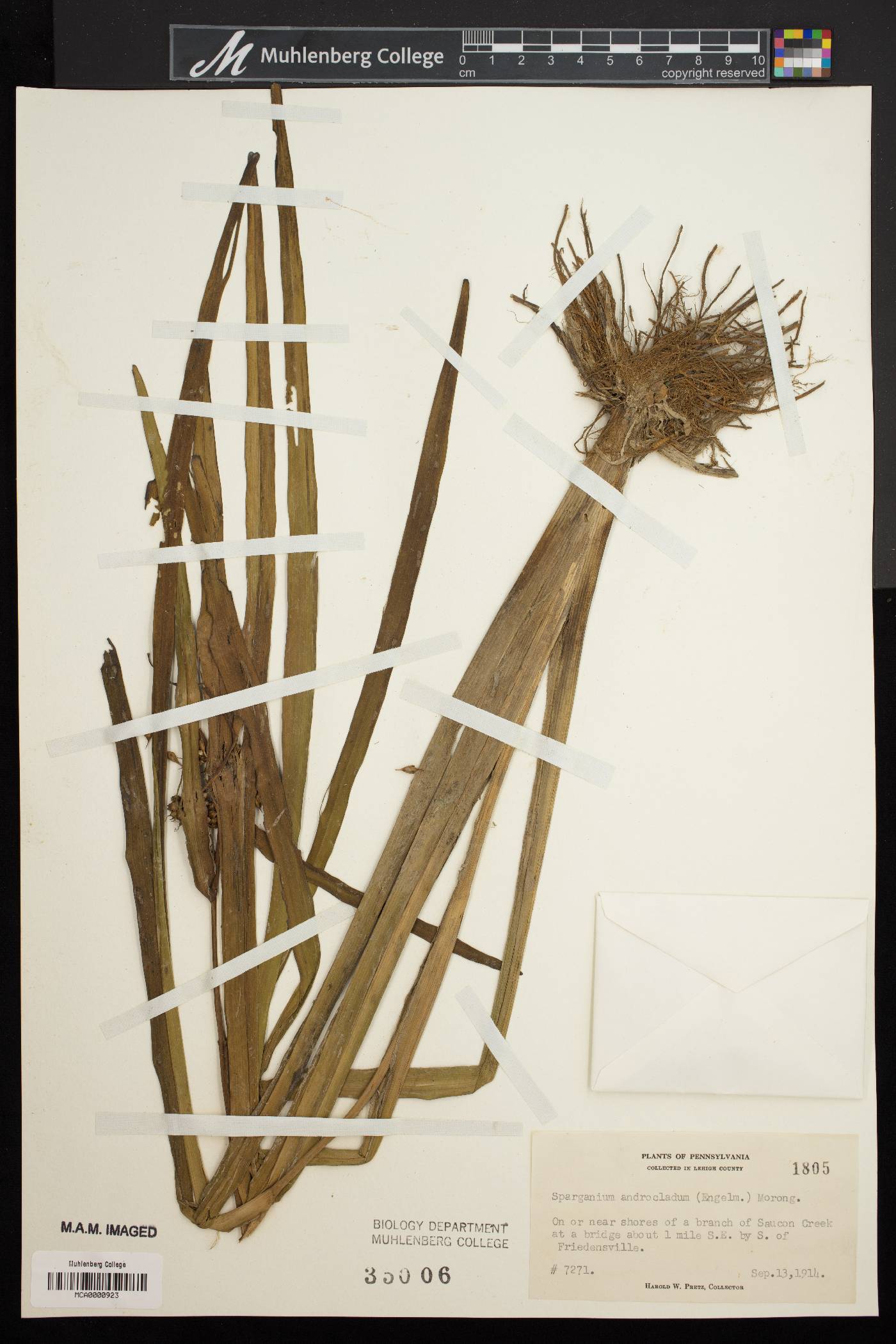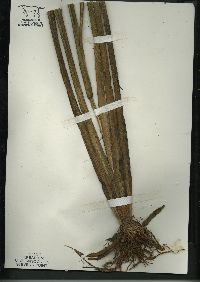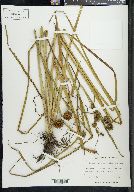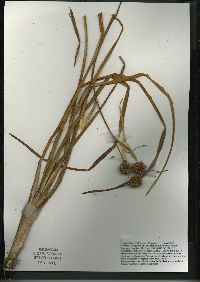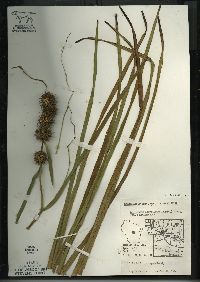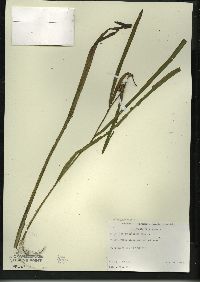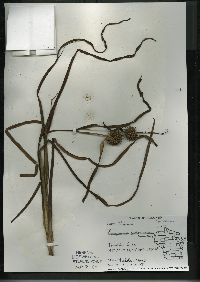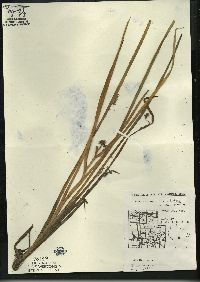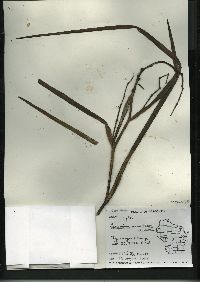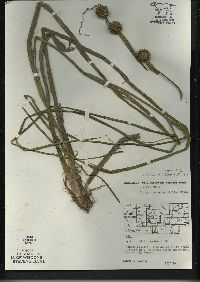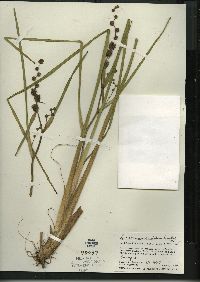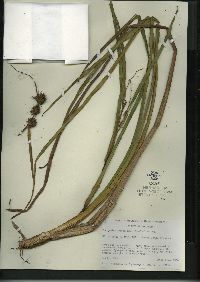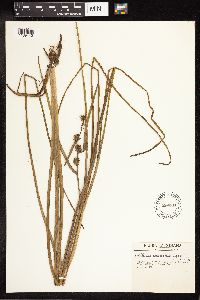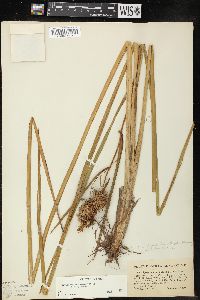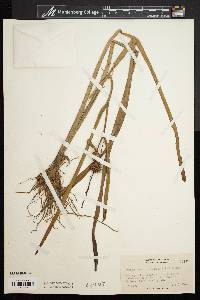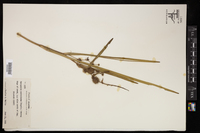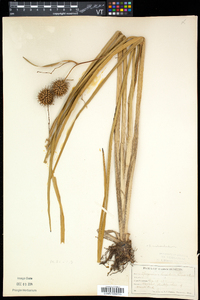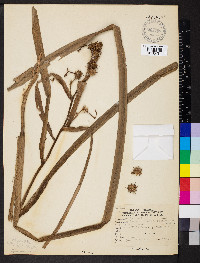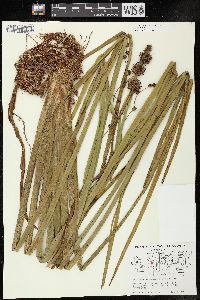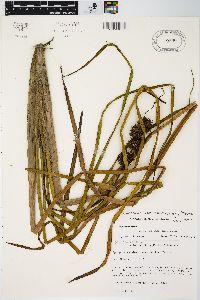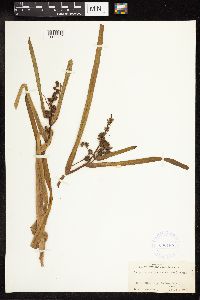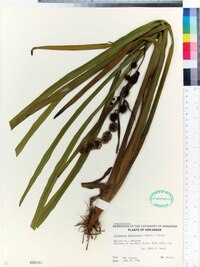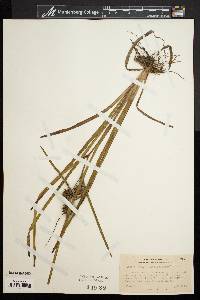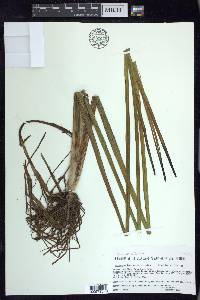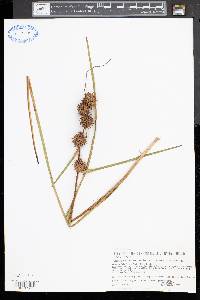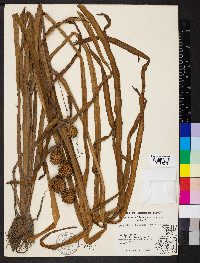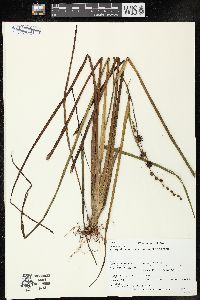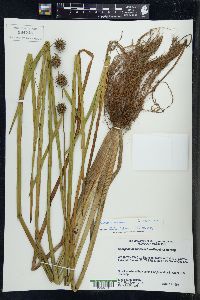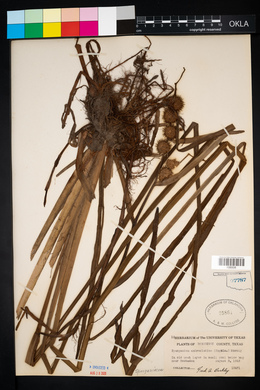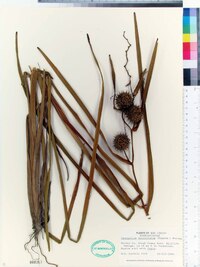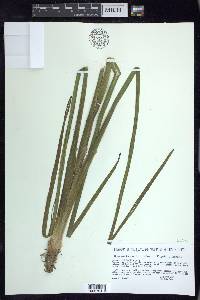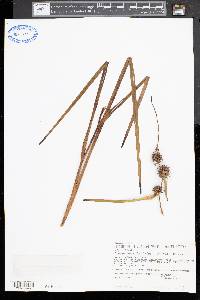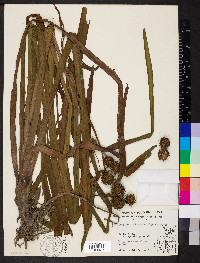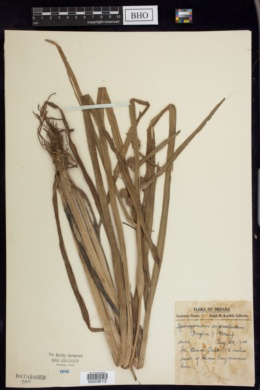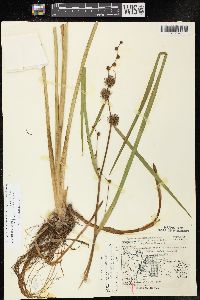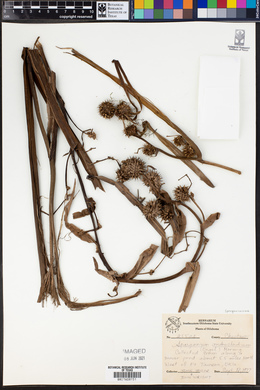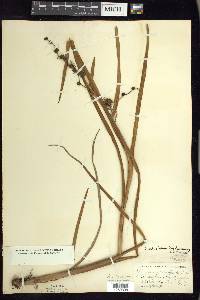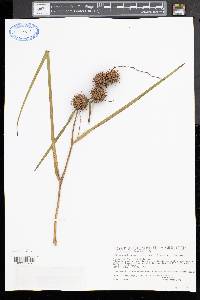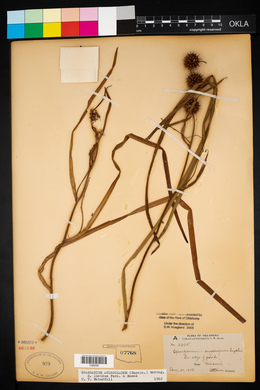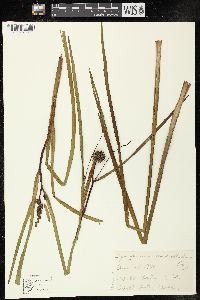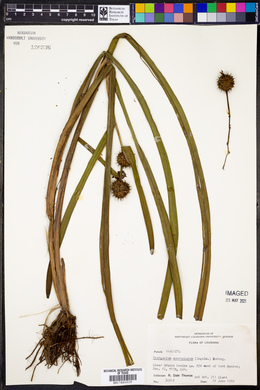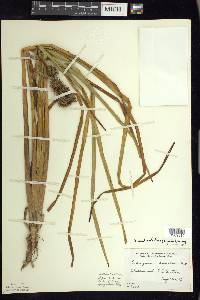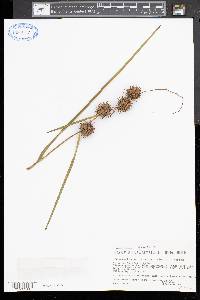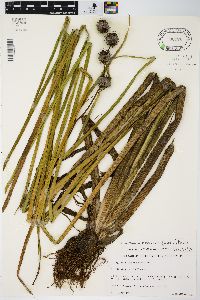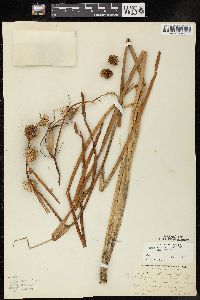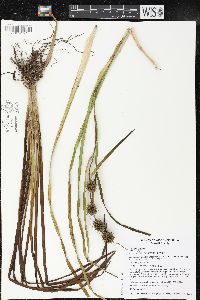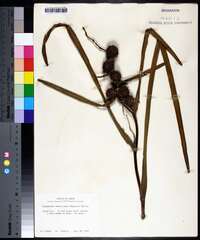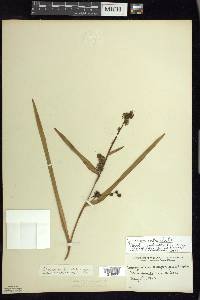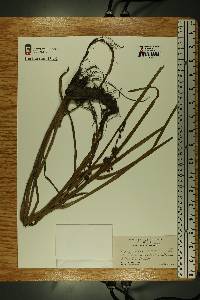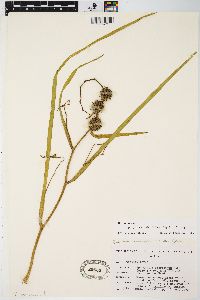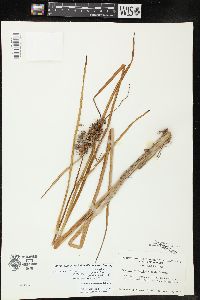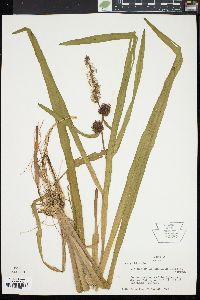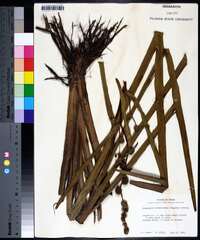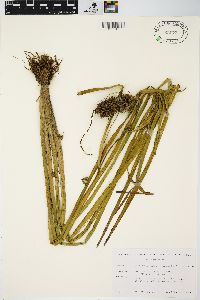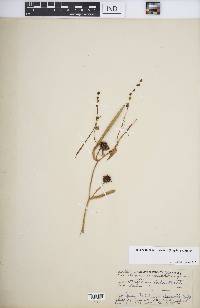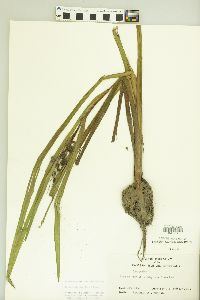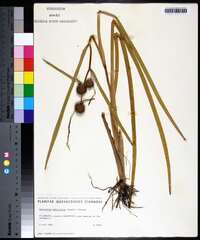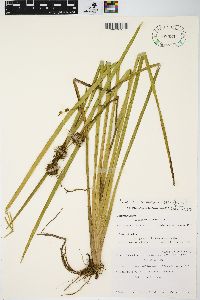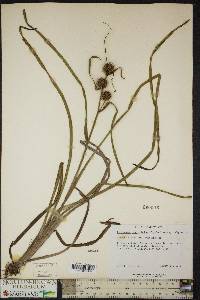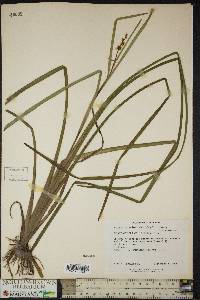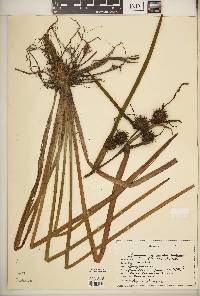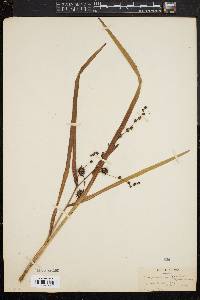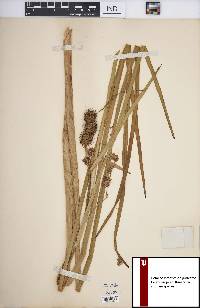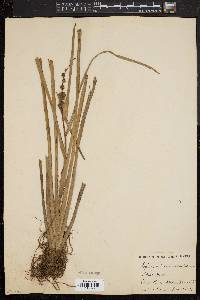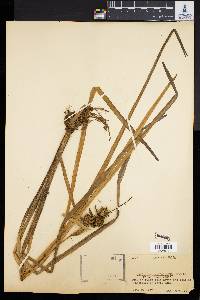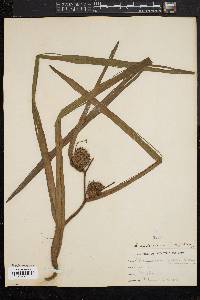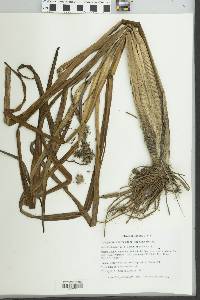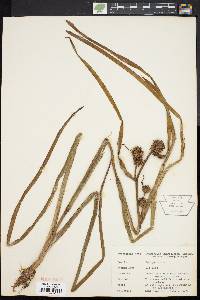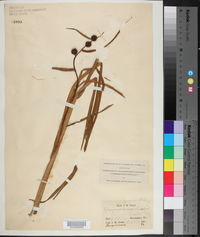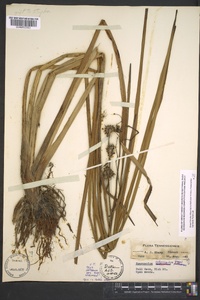Sparganium androcladum
|
|
|
|
Family: Typhaceae
Branched Burr-Reed, more...branched bur-reed
[Sparganium americanum var. androcladum, moreSparganium simplex var. androcladum Engelm.] |
Plants robust, to 1.2 m; leaves and inflorescences erect, emergent. Leaves stiff, keeled from base at least to middle, flattened distally, to 1.2 m 5--15 mm. Inflorescences: rachis (0--)1--3 branched, erect, bracts strongly ascending, not basally inflated; pistillate heads (1--)2--4 on main rachis, 0(--2) on lateral branches, axillary, not contiguous, sessile or short-peduncled, 2.5--3.5 cm diam. in fruit; staminate heads 3--8 on main rachis, 1--6 on lateral rachises, most not contiguous. Flowers: tepals often with prominent subapical dark spot, subentire to entire; stigma 1, linear. Fruits brown, proximally dull, distally shiny, subsessile to short-stipitate, fusiform, usually constricted near equator, body not strongly faceted, 5--7 2.5--3 mm, tapering to beak; beak often curved and hooked, 4--7 mm; tepals attached at base, reaching to equator or somewhat beyond. Seeds 1. Flowering late spring--summer (Apr--Jul). Shores and shallow, quiet, circumneutral waters; 0--800 m; Ont., Que.; Ark., Conn., Ill., Ind., Iowa, Ky., Maine, Mass., Mich., Minn., Mo., N.H., N.J., N.Y., Ohio, Okla., Pa., R.I., Tenn., Vt., W.Va., Wis. Sparganium androcladum is less variable than the similar and more common S. americanum, from which it is distinguished by its generally larger size and more robust habit; leaves stiffer, wider, more strongly keeled; inflorescence branches usually without pistillate heads, the bracts ascending; fruiting heads larger; fruits distally shiny, the beak longer and hooked. Immature fruits of S. androcladum resemble mature fruits of S. americanum. Some specimens will not key readily to either species. The complex nomenclatural history is discussed by C. D. K. Cook and M. S. Nicholls (1987). Sparganium androcladum has an unusual, discontinuous distribution, which is wholly within the range of S. americanum, except in the central Mississippi Valley (M. L. Fernald 1922b). In the absence of convincing specimens, the presence of S. androcladum in Virginia cannot be confirmed, although E. O. Beal (1960) reported it there, and it occurs nearby in West Virginia.
Perennial aquatic herb to 1.2 m tall Leaves: emersed, to 1.2 m long, 5 - 15 mm wide, erect and stiff, longitudinally folded from the base to at least the middle, flattened near tip. Inflorescence: emersed, bracts strongly ascending but not inflated near base, main axis one- to three-branched. Male flower heads are usually not tightly clustered, and are borne three to eight on the main axis and one to six on lateral branches. Female flower heads axillary, stalkless or short-stalked, not tightly clustered, and borne one to four on the main axis but usually absent on lateral branches. Flowers: tiny, with one linear stigma and tepals often having a dark spot near the tip. Fruit: a single-seeded achene-like drupe borne in a head 2.5 - 3.5 cm across, brown, 5 - 7 mm long, 2.5 - 3 mm across, spindle-shaped, tapering to a 4 - 7 mm long beak that is often curved and hooked, usually constricted near middle, dull near base but shiny near tip, the persistent tepals extending to the middle or longer. Similar species: Sparganium eurycarpum is easily distinguished by having two stigmas in most female flowers and inverse pyramidal fruit. Sparganium natans, Sparganium angustifolium, and Sparganium emersum have leaves and inflorescences that are limp and floating, and the inflorescences are unbrached. However, some S. emersum may also have erect, emersed leaves. The very similar Sparganium americanum has some inflorescence branches bearing one to three female flower heads, dull 1.5 - 2.5 cm fruiting heads, more or less ascending bracts, 3 - 5 mm beaks, and leaves with a flat cross-section. Flowering: early July to mid August Habitat and ecology: Rare in fens of the western Chicago Region, but frequent in clean lakes of La Porte, Indiana. Occurence in the Chicago region: native Etymology: Sparganium comes from the Greek word sparganion, a derivation of the word sparganon, meaning swaddling-band. This refers to the ribbon-like leaves of these plants. Androcladum means "with male branches." Author: The Morton Arboretum Stout, erect, 4-10 dm; lvs to 8 dm, 5-12 mm wide, some or all carinate or triangular in cross-section; bracteal lvs ascending; infl simple or sometimes branched; pistillate heads on the central axis 2-4, on the branches none or seldom 1 or 2, all sessile, 3 cm thick when ripe; tep spatulate, two-thirds as long as the achene; stipe 2-4 mm; achene-body shining, pale brown, ellipsoid-fusiform, 5.5-7 mm, slightly constricted, the beak straight, 4-6 mm; stigma 1.5-3 mm; staminate heads 3 or more on the branches, 5-8 on the central axis; anthers linear, 1-1.5 mm. Muddy shores and shallow water; Que. to Va.; O. to Minn. and Mo. (S. lucidum) Gleason, Henry A. & Cronquist, Arthur J. 1991. Manual of vascular plants of northeastern United States and adjacent Canada. lxxv + 910 pp. ©The New York Botanical Garden. All rights reserved. Used by permission. From Flora of Indiana (1940) by Charles C. Deam My only specimen is from a slough about 4 miles northwest of Grayville, Sullivan County. A specimen reported from St. Joseph County should now be referred to Sparganium chlorocarpum. The species of this genus are not well known, hence their distribution is not, as yet, understood. …… Indiana Coefficient of Conservatism: C = 9 Wetland Indicator Status: OBL |

